Asus TUF B760M-BTF WiFi D4 in detail
Why put connectors from the front of the motherboard when they can be from the back? This is what Asus and other manufacturers are thinking with boards with, say, an inverted connector layout. The TUF B760M-BTF WiFi (D4) model has all connectors moved from front to back. This, with the current trend of glass side panels, mainly contributes to a nicer look. But we’ll also be interested in other, measurable things as part of our analysis.
The BTF designation is used by Asus for motherboards where the connectors are located at the back of the PCB instead of the traditional placement on the front. We recently had a report on the ROG Maximus Z790 Hero BTF motherboard, now we’re going to take a closer look at the TUF B760M-BTF WiFi D4. At its core, this is an affordable motherboard with support for LGA 1700 platform processors (from Alder Lake to Raptor Lake Refresh) and DDR4 memory. Compared to most, it is different mainly in that the cables from the PSU or other components (case, fans, etc.) connect to it from the opposite side.
The advantage of such a solution is supposed to be mainly in the fact that cables will not be visible through a glass side panel of a case and such a computer (with an Asus BTF motherboard) will be a nicer sight. The obvious disadvantage of this concept is in the narrower to very narrow compatibility with computer cases. Installation in conventional cases is impossible, if only because the BTF board requires either a significantly larger offset of the PCB from the standoffs or, and this seems more sensible, holes in the tray plate to prevent collisions of the case with the connectors or, consequently, the cabling.
Among the supported cases, for example, is the Asus A21 and more are expected to be added. Gigabyte and MSI also use a scheme with connectors from the back of their motherboards. This makes it an attractive topic for third-party case manufacturers as well. We have information that by the end of the year Cooler Master, Corsair or Phanteks will also launch their new models with support for such non-traditional motherboards. However, we cannot confirm this with 100% certainty. These companies have not been able to confirm anything at the moment and we don’t have any more details on this matter. Anyway, it doesn’t change the fact that support for cases is weaker at the moment, but there is that promise of improvement in the future. We’ll see how it eventually pans out…
| Parameters | Asus TUF B760M BTF WiFi D4 | |
| MSI MAG Z690 Tomahawk DDR4 | ||
| Socket | Intel LGA 1700 | |
| Chipset | Intel B760 | |
| Format | ATX (244 × 244 mm) | |
| CPU power delivery | 14-phase | |
| Supported memory (and max. frequency) | DDR4 (5333 MHz) | |
| Slots PCIe ×16 (+ PCIe ×1) | 2× (+ 1×) | |
| Centre of socket to first PCIe ×16 slot | 80 mm | |
| Centre of socket to first DIMM slot | 56 mm | |
| Storage connectors | 4× SATA III, 2× PCIe 4.0 ×4 (42–80 mm), 1× M.2 PCIe 4.0 ×4 (80 mm) | |
| PWM connectors for fans or AIO pump | 5× | |
| Internal USB ports | 1× 3.2 gen. 2 type C, 2× 3.2 gen. 1 type A, 4× 2.0 type A | |
| Other internal connectors | 1× TPM, 3× ARGB LED (5 V), 1× RGB LED (12 V) 1× jumper Clear CMOS | |
| POST display | no (but has debug LED) | |
| Buttons | Flash BIOS, Clear CMOS | |
| External USB ports | 1× 3.2 gen. 2×2 type C, 2× 3.2 gen. 2 (1× type C + 1× type A), 3× (1× type C + 2× type A), 4× 2.0 type A | |
| Video outputs | 1× HDMI 2.1, 1× DisplayPort 1.4 | |
| Network | 1× RJ-45 (2,5 GbE) – Realtek RTL8125, WiFi 6 (802.11 a/b/g/n/ac/ax), Bluetooth 5.2 | |
| Audio | Realtek ALC897 (7.1) | |
| Other external connectors | – | |
| Suggested retail price | 187 EUR |
Asus TUF B760M-BTF WiFi D4
Categorically, one can write about a lower-middle-class motherboard. In terms of price and features. The Intel B760 chipset is used here and the variant with “D4” in the name is characterized by support for the DDR4 memory standard. These are still attractive in cheaper builds because you can get a better price/performance ratio with them, although these older memories (DDR4) are already in moral obsolescence. Alternatively, Asus also offers a variant of this board for DDR5 memory – the TUF B760M-BTF WiFi. But the price is already higher. Not only for the motherboard itself, but then also for the memory. As always it’s about priorities.
The format of the PCB corresponds to the Micro ATX dimensions, using a larger width (244 mm). This provides up to four DIMM slots for installing memory modules, which is not commonplace on smaller than ATX motherboards. The TUF B760M-BTF WiFi D4 is smaller mainly in height (at 244mm), which is why it is offered in combination with shorter cases, which include the aforementioned Asus A21. So despite being a prettier motherboard, it still has three PCI Express slots, two of which are physically in the ×16 format, but the bottom one only works in PCIe 4.0 ×16 mode. The top one, however, is full-size and with support for the fastest PCIe 5.0 interface.
The third PCIe slot is ×1, suitable for installing simple expansion cards. There is only room for single-slot cards in the bottom two PCIe slots, and the distance between the CPU socket and the first PCIe ×16 slot is also relatively smaller. From the center of the CPU socket to the center of the PCIe slot socket, it’s “only” 80 mm. Thus, in certain situations, wider tower coolers can collide with their (for example, protruding) clips, with graphics cards. Beware of this. Although it was possible to get the three PCIe slots even on the mATX format, it was at the cost of such compromises, which you may not care about even if you use the most powerful CPU coolers, if you already have a liquid cooler selected.
On the front of the motherboard, you won’t find a single connector to run a cable to. There are, however, two of the three M.2 slots with PCIe 4.0×16 SSD support. The third slot (M.2 for SSD) is already at the back. In case you fit an SSD into it, the last PCIe slot on the front is automatically disabled. This is because it shares the same PCI Express lanes.
The connectors are aligned as close to the edge of the PCB as possible. This way you don’t have to connect one from the middle, as is sometimes the case with fan connectors. The only connector that is more deeply recessed towards the center of the motherboard is the M.2 slot. However, it doesn’t need a cable connection to function as it is connected by wires inside the PCB of the motherboard.
The connectors for CPU power are also on the back. The benefit of this position is also that the VRM heatsinks can be a bit larger. Their design on the TUF B760M-BTF WiFi D4 encroaches into a space that they would not be able to if the connectors were on the front due to a potential clash.
The use of space for the VRM heatsinks, which would otherwise contain the power connectors, can be seen well in frontal view. Aluminum fins on the top cover half of the total 12 pins of the two power connectors.
The TUF B760M-BTF WiFi D4 has a 14-phase (12+1+1) power delivery, where the majority (Vcore) of the integrated circuits with MOSFETs is made up of SiC639 (Vishay) chips. The PWM controller is then a ASP2100R (OnSemi).
Next to the DIMM slots, there is only the power delivery and the tin-plated feet of the 24-pin ATX connector. The latter is physically already on the other side of the motherboard.
The rear panel with external I/O connectors is notable, for example, due to the trio of USB-C ports. Such a setup is quite unusual in this price range, although it should be noted that there is only one 20-gigabit one. In total, there are up to ten USB ports on the rear panel, which is quite a lot, but only a few of them are really fast when you consider that four are of the 2.0 standard and three are “only” 5-gigabit (3.2 gen. 1 standard).
The audio output is simpler, there are three 3.5mm jacks for connection and the codec is Realtek ALC897.
Please note: The article continues in the following chapters.
- Contents
- Asus TUF B760M-BTF WiFi D4 in detail
- What it looks like in the BIOS
- Methodology: Performance tests
- Methodology: How we measure power draw
- Methodology: Temperature and frequency measurements
- Test setup
- 3DMark
- Borderlands 3
- F1 2020
- Metro Exodus
- Shadow of the Tomb Raider
- Total War Saga: Troy
- PCMark and Geekbench
- Web performance
- 3D rendering: Cinebench, Blender, ...
- Video 1/2: Adobe Premiere Pro
- Video 2/2: DaVinci Resolve Studio
- Graphics effects: Adobe After Effects
- Video encoding
- Audio encoding
- Photos: Adobe Photoshop, Affinity Photo, ...
- (De)compression
- (De)encryption
- Numerical computing
- Simulations
- Memory and cache tests
- M.2 (SSD) slots speed
- USB ports speed
- Ethernet speed
- Power draw without power limits
- Power draw with power limits
- Achieved CPU clock speed
- CPU temperature
- VRM temperature – thermal imaging of Vcore and SOC
- SSD temperature
- Chipset temperature (south bridge)
- Conclusion





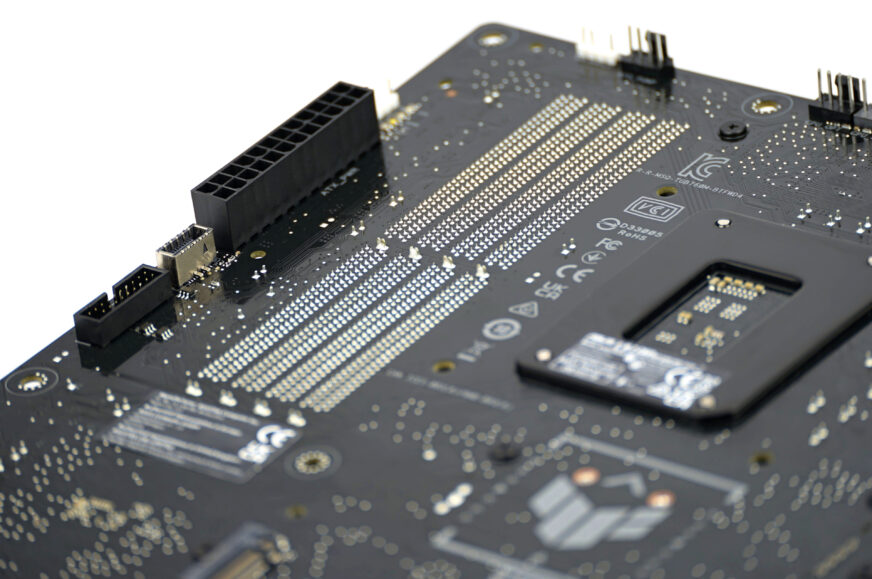
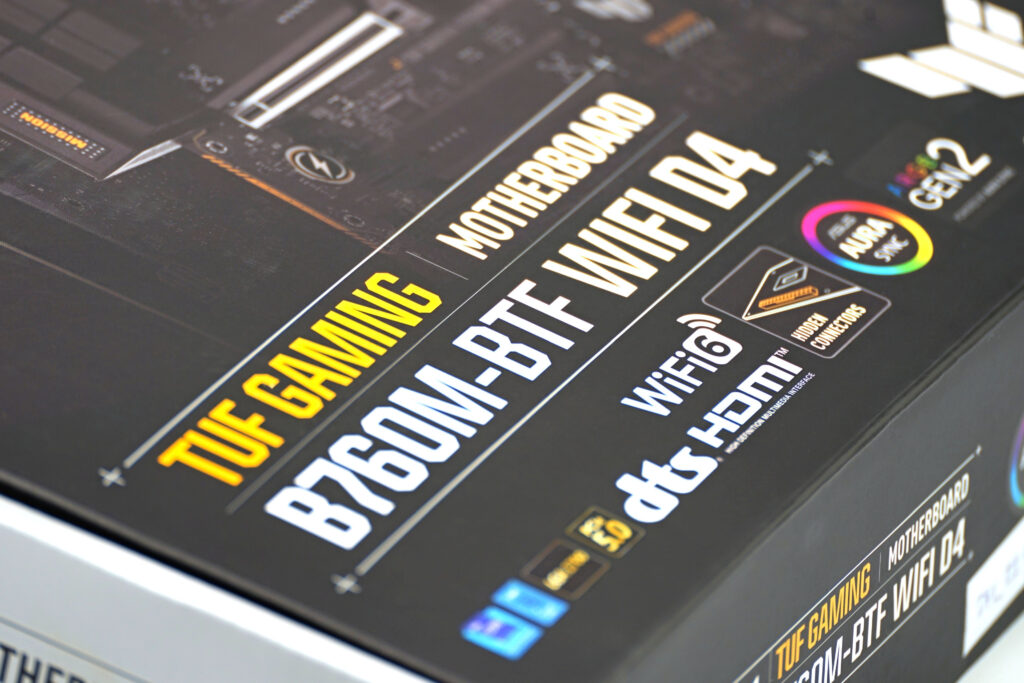

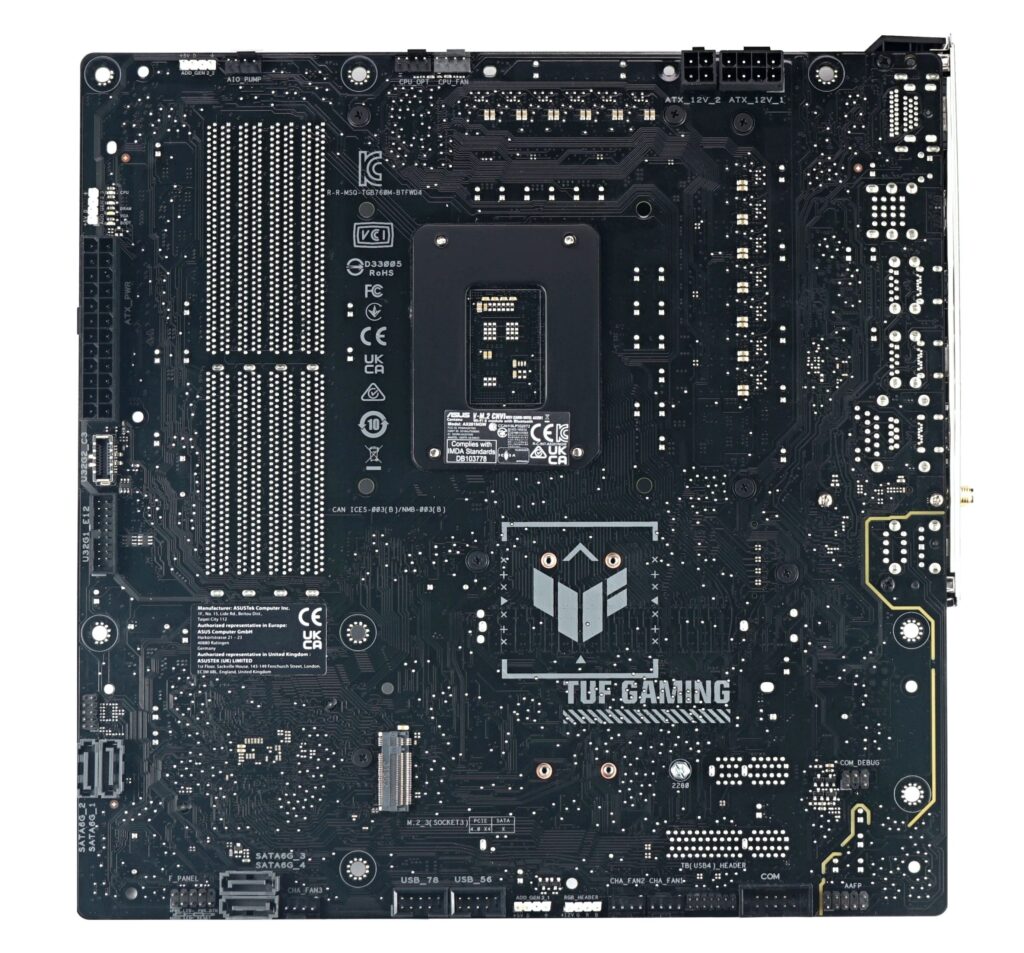

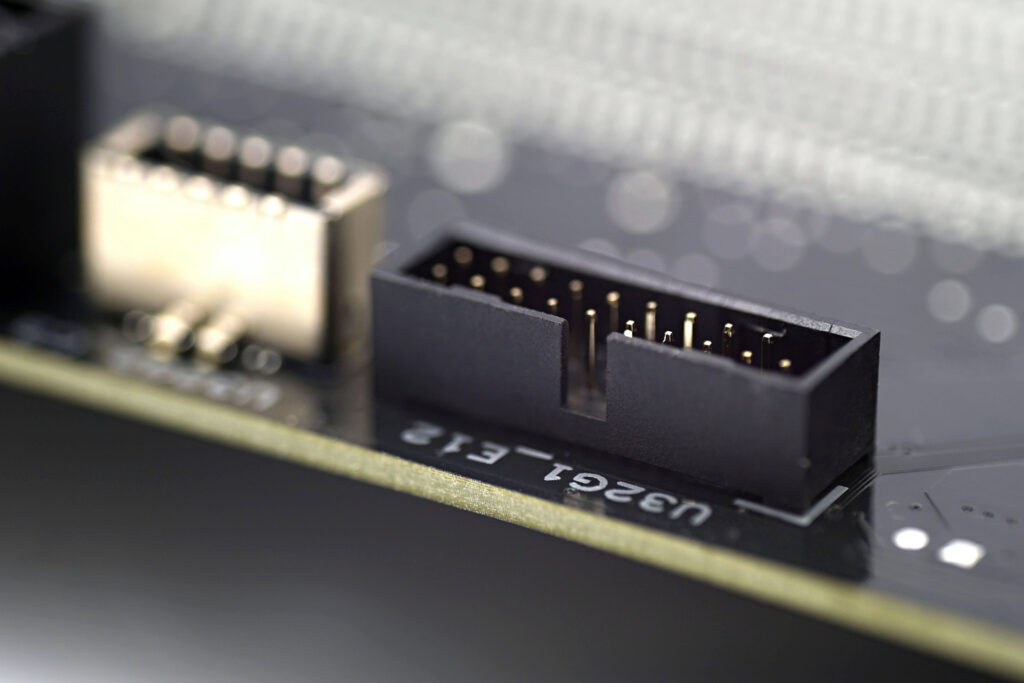

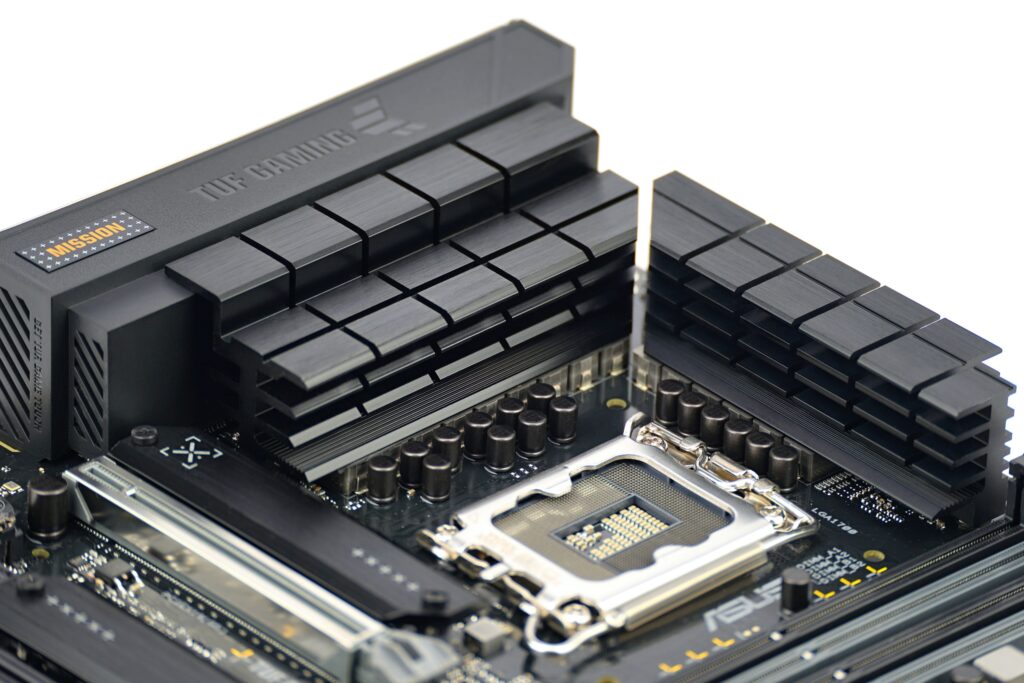
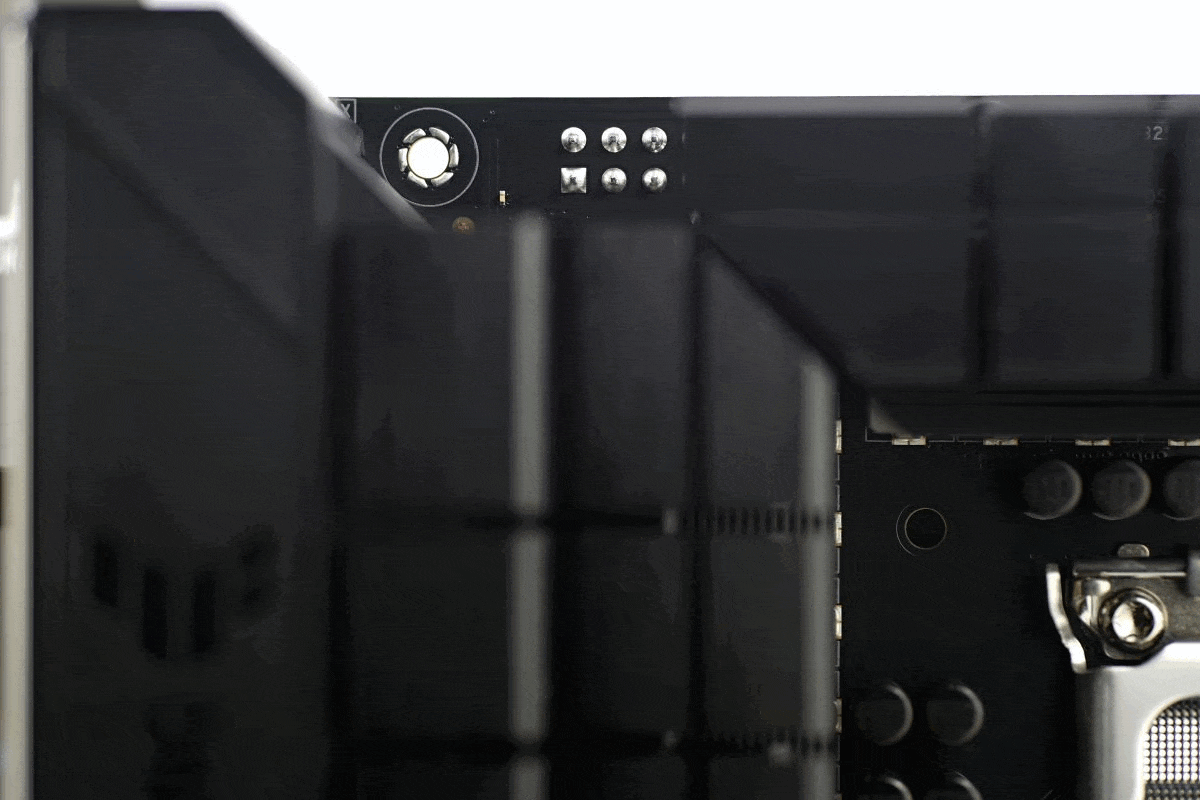
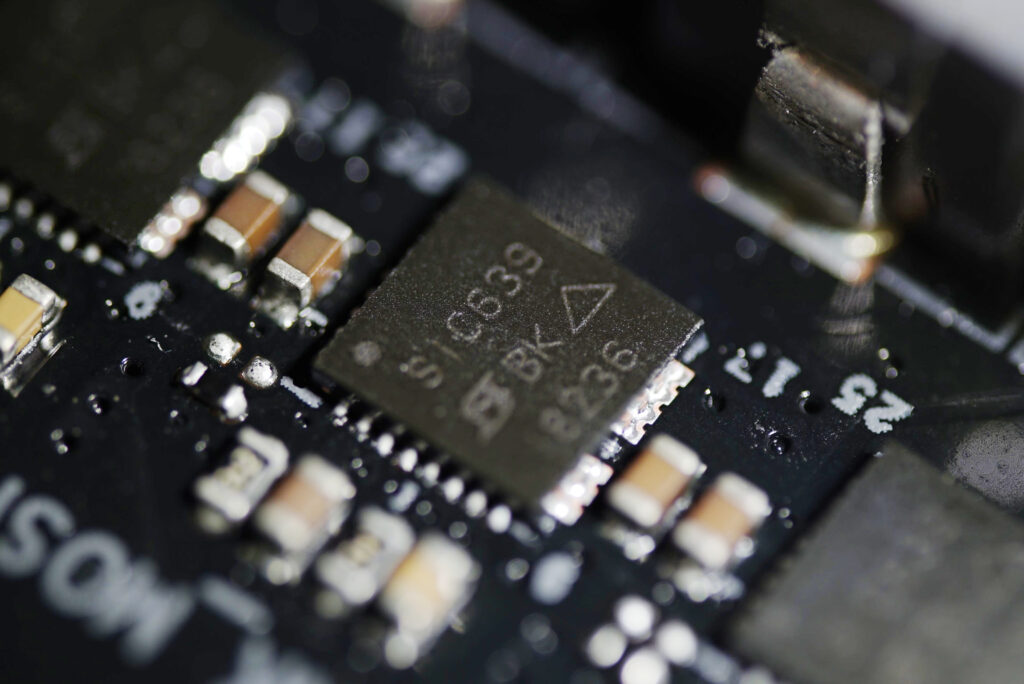

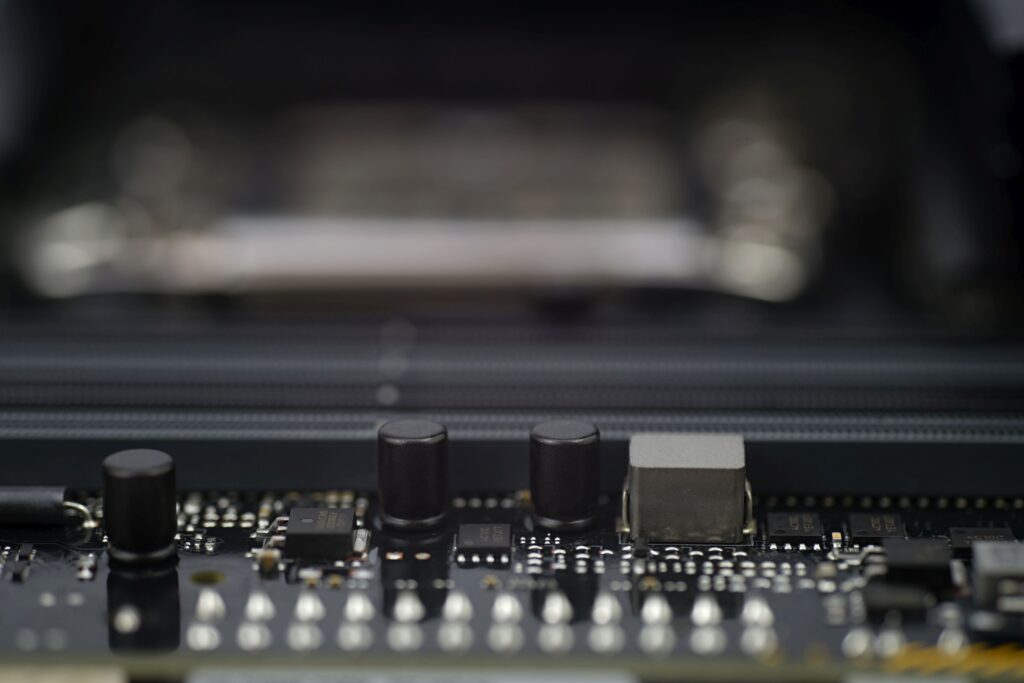

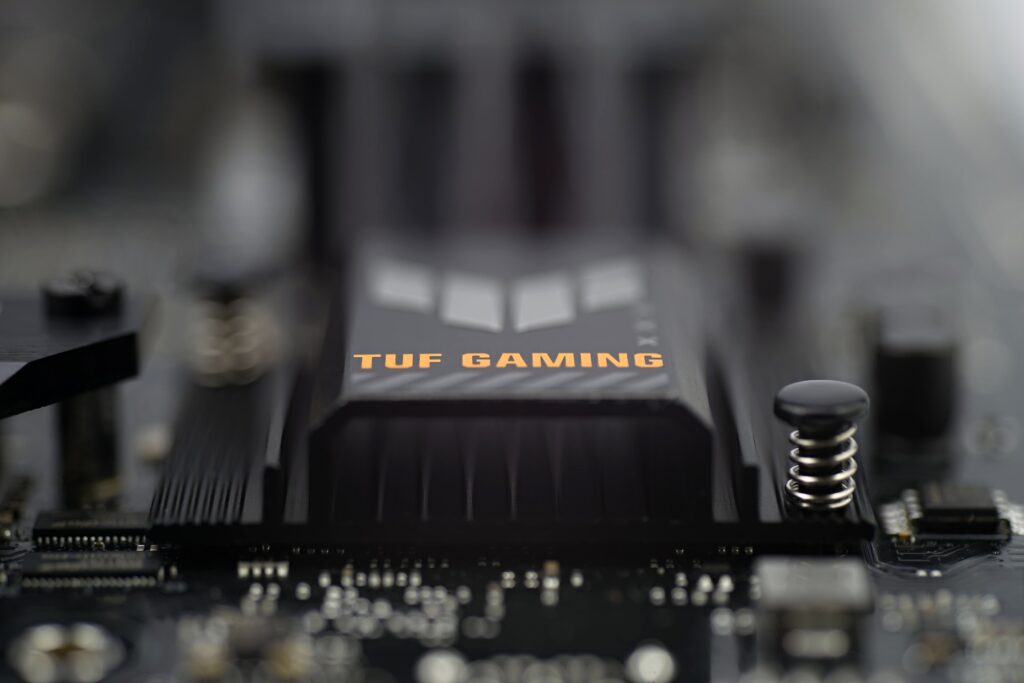
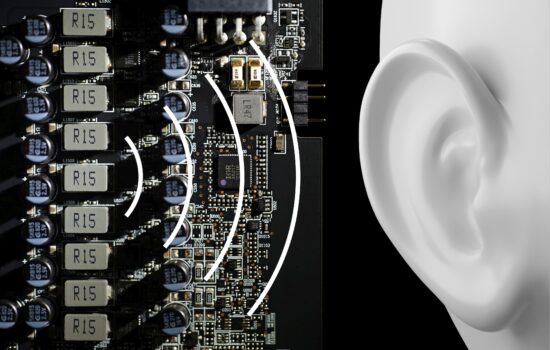





One small note on supported cases. Asus BTF motherboards are also supported by Corsair’s now available 6500 and 2500 series cases. The 2500D Airflow, 2500X, and 2500X RGB models also fit nicely with the TUF B760M-BTF WiFi D4 in terms of form factor, as the combination of a mATX motherboard with a midi-tower case is mentioned.